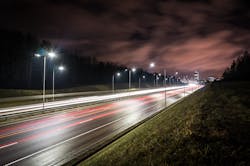The Future of Street Lighting in Smart Cities
By TE Connectivity
The idea of smart cities is built on the importance of connection — the connection between the components themselves and to the people who use them. This hyper-connection is often described as the industrial internet of things (IIoT), which is quickly and powerfully changing how data is shared and managed.
Using IIoT for smart cities is a promising solution for sustainable urban growth. Data-driven decisions reduce environmental footprints, improve infrastructure, and enhance the overall quality of life. With context-specific information, municipalities can determine how to efficiently allocate energy and plan for population growth. However, city decision-makers must also consider the most viable way to start building out a smart city infrastructure. Building and creating a new system from scratch takes a significant amount of time and money. A more realistic first step is to use existing assets — streetlights and poles, for example.
Illuminating the future
Rather than viewing streetlights as just luminaires, let’s reimagine their functionality as EV charging stations, Wi-Fi towers, and pollution monitors. Adapting this existing streetlight infrastructure opens new doors of possibility and has the potential to dramatically improve the efficiency and roll out of new technologies to smart cities. To reach this futuristic idea of street lighting, new technology is also needed at the luminaire to enhance the connectivity and communication features of the single-node architecture. The answer? Two-node architecture.
Currently, streetlights are powered and controlled by a single-node architecture design. This means traditional streetlights use either an ANSI C136 standard connection or a Zhaga Book 18 standard interface to connect control modules to the luminaire. This connection enables basic operations, such as turning the light on and off, as well as communication to the cloud in sophisticated devices. However, single-node architecture does not enable many capabilities outside of lights on, lights dim, lights off.
Transitioning to two-node architecture opens a world of possibilities for energy savings and increased safety with IIoT data, which ultimately improves the overall quality of life in the move toward smart cities. The major benefit of a dual-node structure is its ability to support additional applications outside of lighting, specifically motion sensors.
Progressive steps
In smart cities, data is key. With the right data, cities can better manage and manipulate resources to reduce waste, improve energy efficiency, enhance safety, and more. Two-node architecture provides more connectivity, more communication, and, as a result, more data than traditional one-node architecture. While a single node can provide some of these capabilities, a hybrid structure allows for a plethora of increased functionality and applications starting with motion detection.
With this increased functionality comes opportunities for better energy management. From the perspective of a municipality, this is both an economic and environmental benefit. Motion sensor dimming technology can reduce the amount of voltage used to power a streetlight, depending on environmental context. If little motion is detected, a light might only operate at around 20% capacity. However, if high amounts of motion are detected, the light will power to 100%. This saves money while reducing light pollution and stray light glare. Motion sensors can also monitor vehicle, bicycle, and pedestrian traffic, providing valuable information to cities around population count and movement.
A large benefit to city residents is the access to more accurate data retrieved via streetlights. Whether this information is accessed through an app on a cell phone or a sign on the highway, citizens can directly receive timely, accurate information about their locale. A second node provides the ability to monitor weather conditions or noise pollution, resulting in real-time, localized information.
Two-node architecture provides increased data, which is the most integral aspect of a smart city. Empowered with this data, cities can optimize energy solutions and develop more sustainable infrastructures.
This article was contributed by TE Connectivity. For more information, visit https://www.te.com.


